Brightspace Learning Environment
Assignments – Save time by copying assignments to other courses you teach | New
Instructors who teach several courses and have the new Assignments > Copy to Other Courses permissions are now able to copy assignments between their courses. The copied assignment includes the following key assignment properties:
- Assignment folder and properties, including instructions, assignment category, and visibility
- Assignment properties including description, attachments (direct file attachments, uploaded from Google Workspace or OneDrive, and audio and video files), and category
- Grade item and grade category
- Availability dates
- Submission and completion information, including the Optional Grade item and the course scheme if used.
- Rubric(s) associated with the assignment. When copying an assignment that uses a shared rubric, instead of linking a copied assignment to a shared rubric, the rubric is also copied. The copied assignment links to the copied rubric. If an assignment uses a rubric that is archived, the rubric is copied and retains the archived state in the destination courses.
The following attributes are not copied:
- Instruction quicklinks and attachment resources created with the Attach link to existing activity action.
- Instruction images added using Insert Image that were saved to course files.
- Availability Release conditions and special access settings
- submission and completion information including group assignment designation.
- Evaluation and Feedback information including Turnitin associations, competency, and outcome associations.
- Content topic associations (for example, if the assignment is linked from content)
NOTE: In some cases, references to links and images that are not copied may result in broken links.
The Copy to Other Courses option appears in the context menu of assignments.
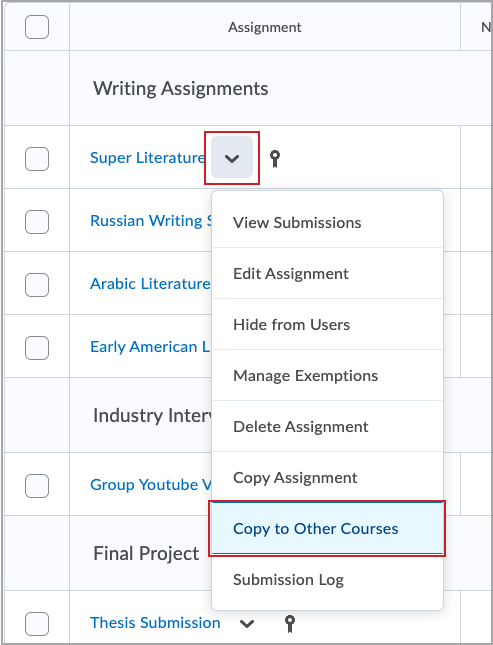
Figure: The Copy Assignments dialog enables you to select the associated rubrics and grade items and choose destinations.
In the Copy Assignment dialog, you can select any rubrics and grade items associated with the selected assignment to include them in the copy package. The Choose Destinations area enables you to search by keyword or semester to find the destination courses for the assignment. Only course offerings for which a user has the Copy to Other Courses permission appear in the Choose Destinations list. By default, the maximum number of courses you can select is 10.
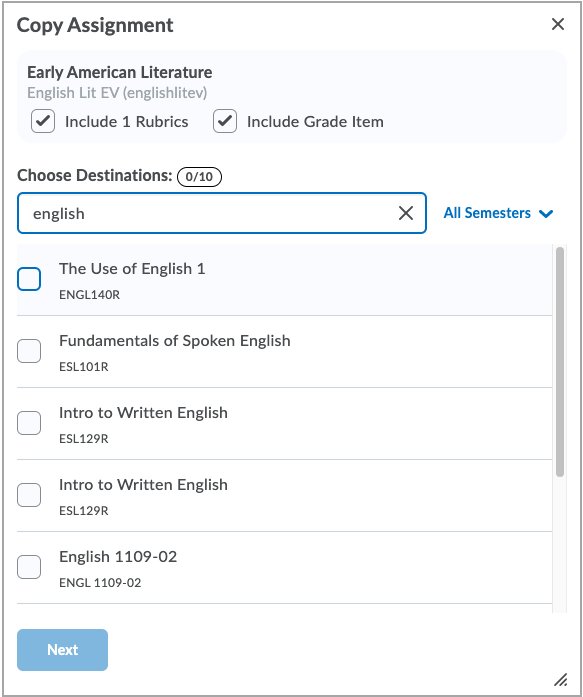
Figure: The Copy Assignments dialog enables you to select the associated rubrics and grade items and choose destinations.
After you have completed the Copy Assignment dialog, the progress page indicates the status of each destination course and any issues. If you navigate away from the progress page, a minibar notification in Brightspace Learning Environment indicates when the assignment has been copied to all the destination courses. You can click the notification to open the progress page to review the status and logged issues.
This feature partially implements PIE item D6762 - Post the same assignment to multiple courses, and D5754 - Export assessments to multiple courses
Technical Details
Impact:
-
Slight impact to instructors due to the ability to copy assignments to other courses.
Availability:
-
This feature is available to all clients.
To enable:
- This functionality is automatically enabled for Assignments users.
- All roles that should be able to copy assignments to other courses must have the new Assignments > Copy to Other Courses permission enabled at the course offering level. Instructors must have the permission in both the originating and destination courses. The Copy to Other Courses permissions must also be granted at the org level.
- Language terms for this new workflow are found in the WebComponents tool package under the d2l-copy-assignment-to-other-courses\copy-assignment-to-other-courses collection.
Brightspace Learning Environment – Improved and consistent multi-contextual filter dialog | Updated
With this release, Brightspace Learning Environment is refreshing the multi-contextual filter dialog user inferface component to ensure consistent filtering functionality across the platform. Changes to the filter dialog include:
- Multi-dimensional filters now represent dimensions in a nested list instead of tabs
- Ensuring that most filter dimensions have a search field
- Changes in padding and styling for applying filters across each dimension
- Improved mobile responsive behavior
Previously, only certain filter dimensions had a search field.
The areas of Brightspace Learning Environment being updated by this feature are:
- My Courses Widget: Department/Semester Filters
- Insights: Filters on various dashboards
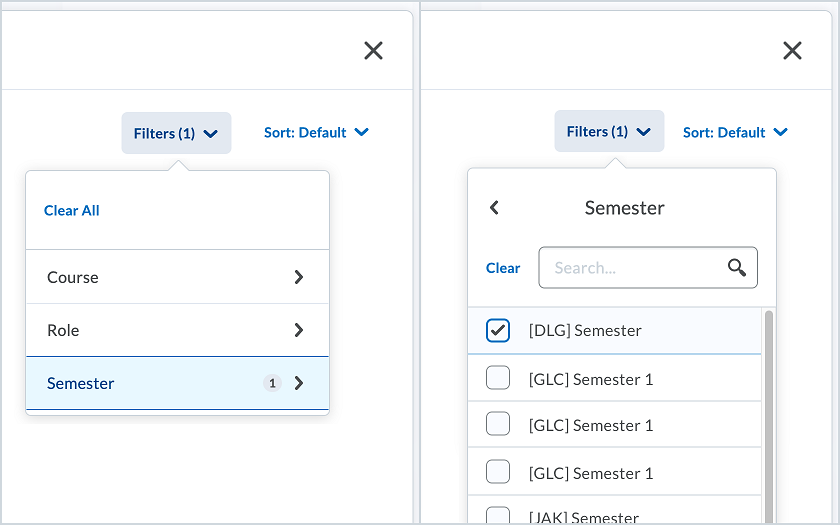
Figure: A comparison of the new and previous My Courses Widget filters.
Technical Details
Impact:
- Slight impact to all users due to the updated user interface of the multi-contextual filter.
Availability:
- This feature is available to all clients.
To enable:
- This feature is automatically enabled.
Brightspace Pulse – Pulse App now only supported on Android 6 / iOS13 and above | Updated
With this release, the Brightspace Pulse App is now only supported on the following mobile operating systems:
- Android 6 and above
- iOS13 and above
This ensures that mobile level support is consistent across all D2L Apps, rather than being on a per-app basis; and consistent with Android and Apple policies concerning operating system support.
Previously, Brightspace Pulse was supported on Android 6 and iOS12 and above.
Technical Details
Impact:
-
Moderate impact to all users using versions before Android 6 or iOS13 due to the removal of support for these operating systems.
Availability:
-
This feature is available to all clients using the Brightspace Pulse app.
To enable:
-
This feature is automatically enabled.
Bulk User Management – Bulk user management enhanced to support optional Gender field | Updated
The Bulk User Management tool is now updated to support the Gender field within Contact Information. The optional Gender field can be used in BulkUserCreate, BulkUserImport, and BulkUserUpdate. Gender is not a new field. Admins can continue to call out the Gender field in Manage Users. This requires it to be enabled via Contact Information.
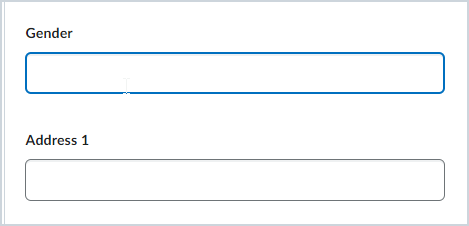
Figure: Gender field in Brightspace Learning Environment.
Technical Details
Impact:
-
Slight impact to administrators if they choose to toggle on the Gender field.
-
Slight impact to instructors if they choose to toggle on the Gender field.
-
Slight impact to learners if they choose to toggle on the Gender field.
Availability
-
Available for all clients.
To Enable:
-
Toggle the Gender field to ON from the default OFF within Contact Information.
Classlist – View user pronouns next to names to further personalize learning | Updated
Classlist can now display users' pronouns next to their names when the new d2l.Tools.Classlist.DisplayPronouns configuration variable is turned ON for the org unit. The default value of this configuration variable is OFF.
The existing org level d2l.Settings.EnablePronouns configuration variable must be turned ON for pronouns to display in Classlist. Users with the existing Set My Pronouns permission enabled for their role can choose whether to display their pronouns to other users in the Account Settings > Pronouns menu. They must check the Allow others to see my pronouns check box for their pronouns to display in Classlist. Users must have the existing See Pronouns permission enabled for their role to see their classmates' pronouns in Classlist.
Previously, the only location where pronouns displayed was in a user's profile card.

Figure: Pronouns display in the 'Last Name, First Name' column of Classlist, to the
right of the user's name, in parentheses. User name text is blue, pronoun text is
grey.
This feature implements PIE items D5207 (Preferred Pronoun field in Classlist) and D8232 (Display Pronouns in Classlist).
Technical Details
Impact:
- Slight impact to administrators due to the ability to choose whether pronouns display in Classlist.
- Slight impact to users due to the ability to see the pronouns of their classmates in Classlist.
Availability:
- This feature is available to all clients.
To enable:
- Set the d2l.Tools.Classlist.DisplayPronouns configuration variable to ON for the org unit.
- Set the org level d2l.Settings.EnablePronouns configuration variable to ON.
- Enable the Account Settings > Set My Pronouns permission for the appropriate user role.
- Enable the User Information Privacy > See Pronouns permission for the appropriate user role.
Group/Section Management – Automate asynchronous group creation with APIs | Updated
This feature implements changes to the group creation APIs so that users can take advantage of the new asynchronous creation method already in use in the Groups tool. When users create a new group category with the API, they receive a 202 Accepted response code indicating that their request is submitted and currently being processed. Any other PUT, POST or DELETE calls against the current processing group category creation will receive a 409 Conflict status to indicate that the action cannot be completed because the group category is not finished processing.
The status of a processing group category creation can be checked via a new API route. The API changes are detailed in the Brightspace ILP Current Release Changes document.
Refer to the Changes to the Group Category creation API workflow article for more details. The addition of the Group/Section Management tool’s new asynchronous group creation was detailed in the Brightspace Platform April 2022 / 20.22.04 Release Notes.
Technical Details
Impact:
-
Moderate impact to instructors who use automated workflows.
Availability
-
This feature is available to all Brightspace clients.
To enable:
-
This feature is automatically enabled for all clients.
Manage Files – New/Edit File workflow change | Updated
Currently, when choosing the New File or Edit File option from Manage Files, users see a dialog open that must be moved or expanded to become properly visible. If users attempt to use the advanced code editor (source code editor), they open a second dialog that is not sized correctly and cannot be resized due to constraints from the first dialog.
Now, the New File and Edit File options in Manage Files open in a new tab in the user's browser in order to support more efficient editing. By allowing the editor to open in a new tab, the advanced code editor dialog now opens fully.
Technical Details
Impact:
-
Slight impact to Instructors since the file now opens in a new tab instead of a dialog.
Availability:
-
This feature is available to all clients.
To enable:
-
This functionality is automatically enabled for Brightspace Learning Environment users.
New Content Experience – Streamline workflows with the replace uploaded files functionality | New
Instructors can now replace uploaded PDF, Word, PPT, and image files when editing a topic in the New Content Experience (Lessons).
This feature does not include HTML or Audio/Video files.

Figure: Lessons > The Edit topic page with the grey banner that appears for uploaded files, weblinks, and LTI
links and holds the Replace button for PDF, Microsoft Word, PPT, and image files.
On clicking Replace, the Add a File dialog box appears. This workflow is consistent as in the Classic Content experience and in Assignments > the File Upload workflow.
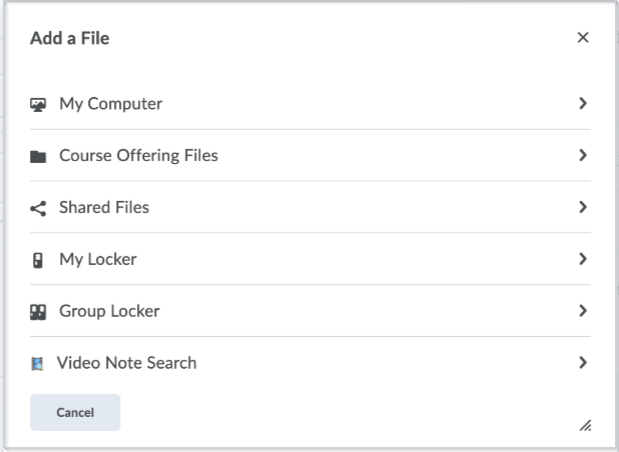
Figure: Add a File dialog box.
Technical Details
Impact:
-
Slight impact to instructors due to the ability to replace uploaded files.
Availability:
-
This feature is available to all Lessons users.
To enable:
-
Ensure that the d2l.Tools.Content.LessonsCreateExperienceOptIn configuration variable is turned ON.
Quizzes – Create engaging assessments quickly with the new quiz creation experience | Updated
The new quiz creation experience brings create and edit consistency changes from Assignments to Quizzes.
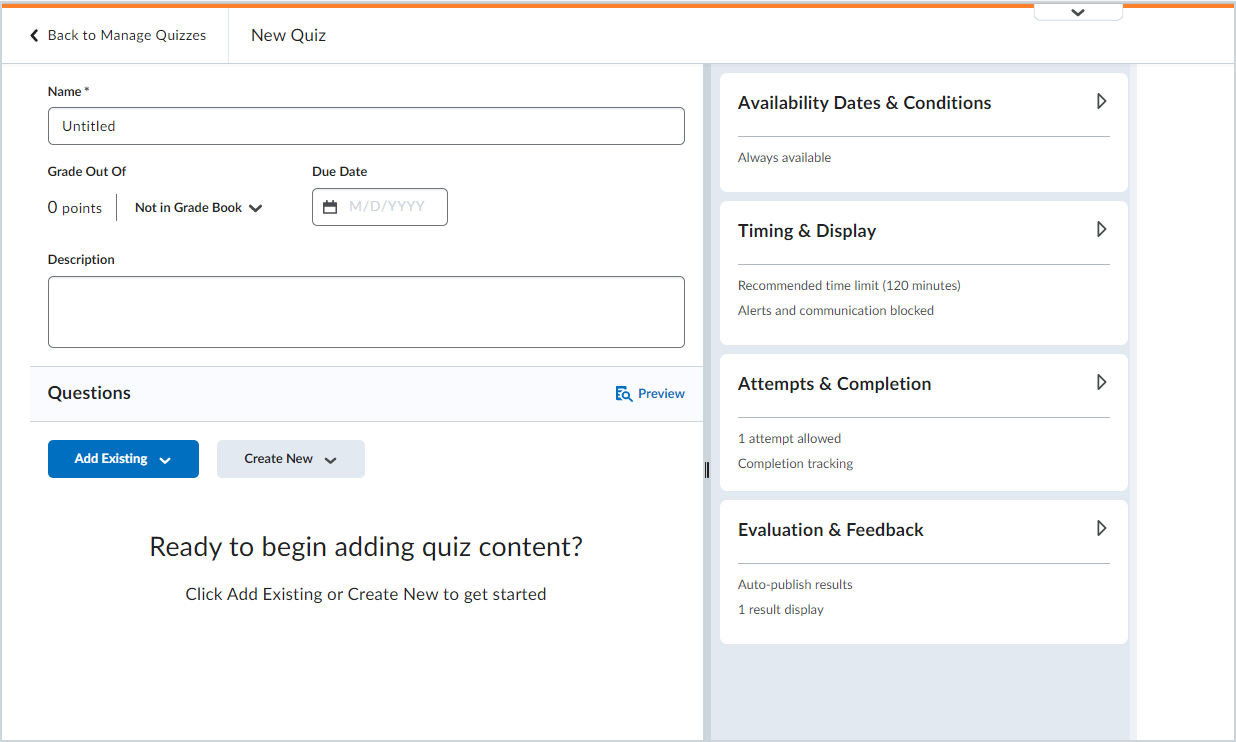
Figure: Quizzes tool in Brightspace Learning Environment.
The primary panel on the left contains common, frequently used fields that are always displayed. These fields are most relevant to learners and are core to quiz creation. The add/edit question workflow has been brought into the primary panel, giving users the ability to easily modify quiz questions without the need to navigate to a separate interface.
The right-hand panel organizes additional, more advanced options such as start and end dates, release conditions, and special access. These options follow the same logical groupings as found in Assignments. Other quiz-specific settings can be found in the right-hand panel including creating a password protected quiz, applying IP restrictions, adjusting quiz timing, setting display options, managing attempts, and altering evaluation and feedback settings.
See the Welcome to the New Quiz Creation Experience knowledge article for an in-depth look at all the feature and capability changes with this update.
Technical Details
Impact:
-
Moderate impact to instructors due to a new create and edit quiz experience that they can opt into or out of within a specific course at any given time.
Availability:
-
This feature is available to all clients.
To enable:
-
Ensure the new configuration variable d2l.Tools.Quizzes.CreateExperienceOptIn is set to ON (Opt-In).
Note: The configuration variable default is OFF.
Rubrics - Quickly determine a Rubrics state with archived tags and selection list descriptions | Updated
To provide consistency with other Rubrics experiences and build on the value of the
Rubrics tool, there are several improvements in this release.
Archived Rubrics now appear with an archived tag
The Archived tag enables users to update rubric versions while keeping the existing evaluation
records available for instructors and learners to review. Previously, when you changed
a rubric, previous evaluations were removed. Now, if you change the status of a rubric
to Archived, there are no effects on the alignment of rubrics to any assessment activities
or previous evaluations that were completed using the rubric. Rubrics that are changed
to an Archived status after the initial alignment to the activity continue to display
and can be used for evaluation. There is a new Archived tag that appears on rubric tiles in activity creation and activity evaluation workflows
to provide information to instructors and course developers that a rubric previously
aligned to an activity is now archived. The Archived tag appears in both full-screen and pop-out views of the rubric in Grades, Competencies,
and in the Consistent Eval experience. In addition, it appears in rubrics results
pages and during evaluation for instructors in collapsed, expanded, and full-screen
view. You cannot add archived rubrics to assessment activities ad new rubric alignments
- this behavior has not changed.
Note: The archived state tag is not visible to learners. If you have been evaluated using
an archived status rubric, the learner can see those evaluations and feedback.
Rubric descriptions now appear in the Rubric picker list
The Rubric selection dialog window now includes the first two rows of the rubric description
to enable instructors and course designers to better identify the version of a rubric
when its name is being reused for a current rubric.
The help description for Status in the Rubrics tool now more clearly explains the
interaction of archived status rubrics
The help text icon now appears next to the Status column heading, and the Archived
Status text now more accurately reflects the available interactions with archived
status rubrics. Specifically, it expands the description to indicate that archived
rubrics do not appear in default search results and cannot be added to activities;
however they can be evaluated. Further, archiving a rubric does not remove it from
activities or published feedback.

Figure: The Archived tag appears under the Rubric title.
Figure: The Archived tag in the Rubrics list of Consistent Evaluation.
Figure: The Archived tag in the Rubrics detail view of Consistent Evaluation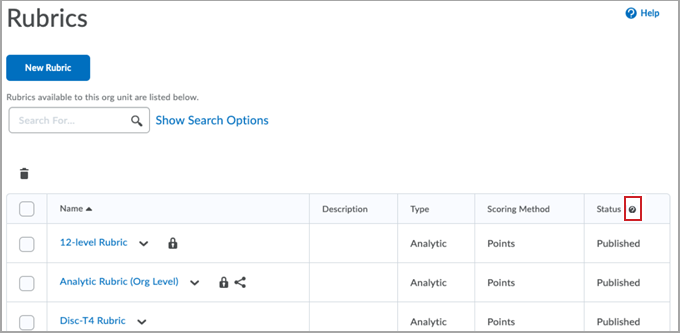
Figure: The new location of the help icon in the Rubric Status column.
Technical Details
Impact:
- Slight impact to instructors due to the ability to the additional Rubric information provided by the Archived tag and rubric description.
Availability:
- This feature is available to all clients who use Rubrics with any assessment tool across the Brightspace Learning Environment.
To enable:
- This functionality is automatically enabled for Rubrics users.
Note: Administrators may see a new Edit Assessed Rubrics permission in the Roles and Permissions tool. This new permission has no bearing on this feature and will be included as part of a future release.
Surveys – Use signed comments feature no longer supported | Removed
The d2l.Tools.Surveys.UseSignedComments configuration variable will be set to zero for all clients and the ability for clients to set the configuration variable will be removed.
This configuration variable controlled the availability of the Signed Comments feature for instructors. This feature allowed instructors to control the visibility of Signed Comments and enabled instructors to add an option to written response questions in anonymous surveys.
This option was not available to instructors since the New Question Creation workflows were set to On for all users in December 2018. However, previously created surveys and questions with this option continued to present the option to learners.
Technical Details
Impact:
-
Slight impact to instructors who have the configuration variable enabled due to the inability to use the feature.
Availability:
-
This feature is available to all clients.
To enable:
-
This feature is automatically enabled for all clients.
Integrations
LTI – Context copy history substitution for all launches provides a more consistent experience | Updated
Currently, when a course is copied in Brightspace, any LTI link that is in the course and copied retains a copy history that is passed to the tool upon launch. This can enable tool providers to use this information to link pre-existing pieces, like media libraries, to the new course seamlessly. However, links that are shared to a course make explicit copies because they are not in the course. Links that are added after the course is copied do not have a context copy history. This could lead to issues on launch for learners.
Now with this feature, Brightspace includes a copy history for all links on launch, not just links that went through a copy process, using the $Context.id.history custom substitution parameter. This custom parameter substitution is optional.
This feature applies to both LTI 1.1 and LTI 1.3.
Technical Details
Impact:
-
Slight impact to Administrators as they can now expect a consistent experience across LTI links in a course.
Availability:
-
This feature is available to all clients on new course copies moving forward from this release.
To enable:
- This functionality is automatically enabled for Brightspace Learning Environment users.
LTI – Improve course import workflows with the creation of LTI Advantage links | Updated
When an IMS Common Cartridge or Brightspace Course Package containing LTI links is imported, Brightspace will now default to create those links as LTI Advantage if a matching LTI Advantage tool is set up with registration, deployment, and sharing rules for that course. In cases where there is no matching LTI Advantage tool setup for that course, the links will be LTI 1.1 if applicable.
For more information about migrating to LTI Advantage, refer to Brightspace Legacy LTI to LTI Advantage Migration Plan on Brightspace Community.
This feature resolves several known issues with the LTI import process.
Technical Details
Impact:
- Slight impact to administrators due to the ability to now have LTI links recognized as LTI Advantage links on import.
Availability:
- This feature is available to all clients.
To enable:
- This functionality is automatically enabled for Brightspace Learning Environment users.
